I recently posted a dual tribute to nature poet extraordinaire, Mary Oliver. I know, I know. I keep bringing her up. But we bring up our favorite poets much like we bring up our favorite composers, songwriters, and authors (and grandkids): over and over again.
Ms. Oliver wrote a lovely poem entitled, “Wild Geese.” Here are some of the lines. My favorites are 3 and 4.
Meanwhile the wild geese, high in the clean blue air,
are heading home again.
Whoever you are, no matter how lonely,
the world offers itself to your imagination,
calls to you like the wild geese, harsh and exciting –
over and over announcing your place
in the family of things.
Now, here’s a photo of some SE Virginia wild geese. They won’t be migrating like the subject of Ms. Oliver’s poem.

And here’s a recording of some SE Virginia wild geese, as well:
A Photography Aside
The above photo is a little too high-key for me and includes some blown highlights. I’m a believer in “exposing to the right,” which, as I understand it, enables a photographer to capture more data. But I went a bit too far here. Nevertheless, I succeeded in capturing the birds’ eyes (and that nice open beak and tongue) against the darker background. One always makes an effort to capture the eyes.
Speaking of open beaks, here’s a close-up of another Canada Goose looking as if it were getting ready for an oral exam. The Elizabeth River in Chesapeake is in the background. Ordinarily, I don’t like to clip birds’ bodies when I shoot, but I decided in this case that it didn’t matter. The bird was close, the lighting was great, the subject was interesting, and I was out of options anyway, toting a 500mm prime.
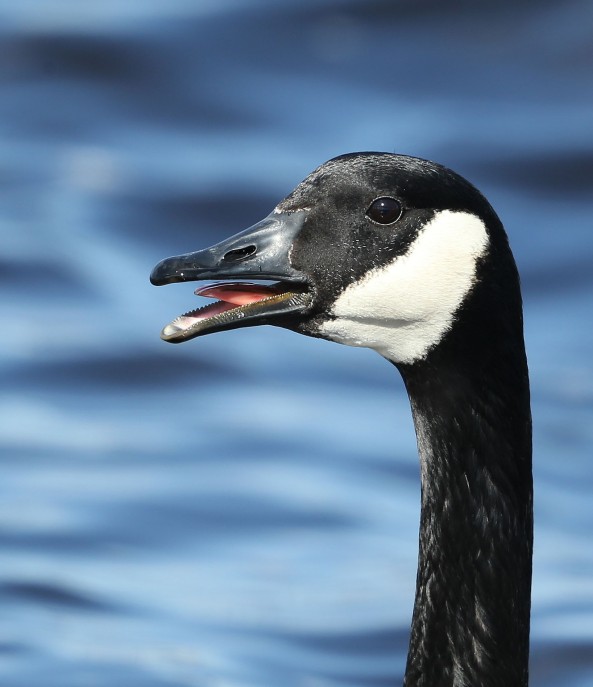
Note that the goose’s lower mandible is serrated. I had no idea. As it turns out, the upper mandible is serrated, too, as is the bird’s tongue. Here’s a great photo that bears all this out. All those serrations help the bird to strain water and to graze. It’s amazing what you can learn when you study your photos. You can find previously unknown features like the above. You can also find leg bands, tracking devices, signs of disease, and more.
Canada Geese, Cont’d
I stated that the geese in the top photo were permanent residents and wouldn’t be migrating. But good numbers of Canada Geese do migrate, just like their cousins the Snow Geese, and their distant cousins, the Tundra Swans. Previously, I’d given little thought to the movement patterns of Canada Geese and had just assumed that most were residents. But then I met Rick, the hunter.
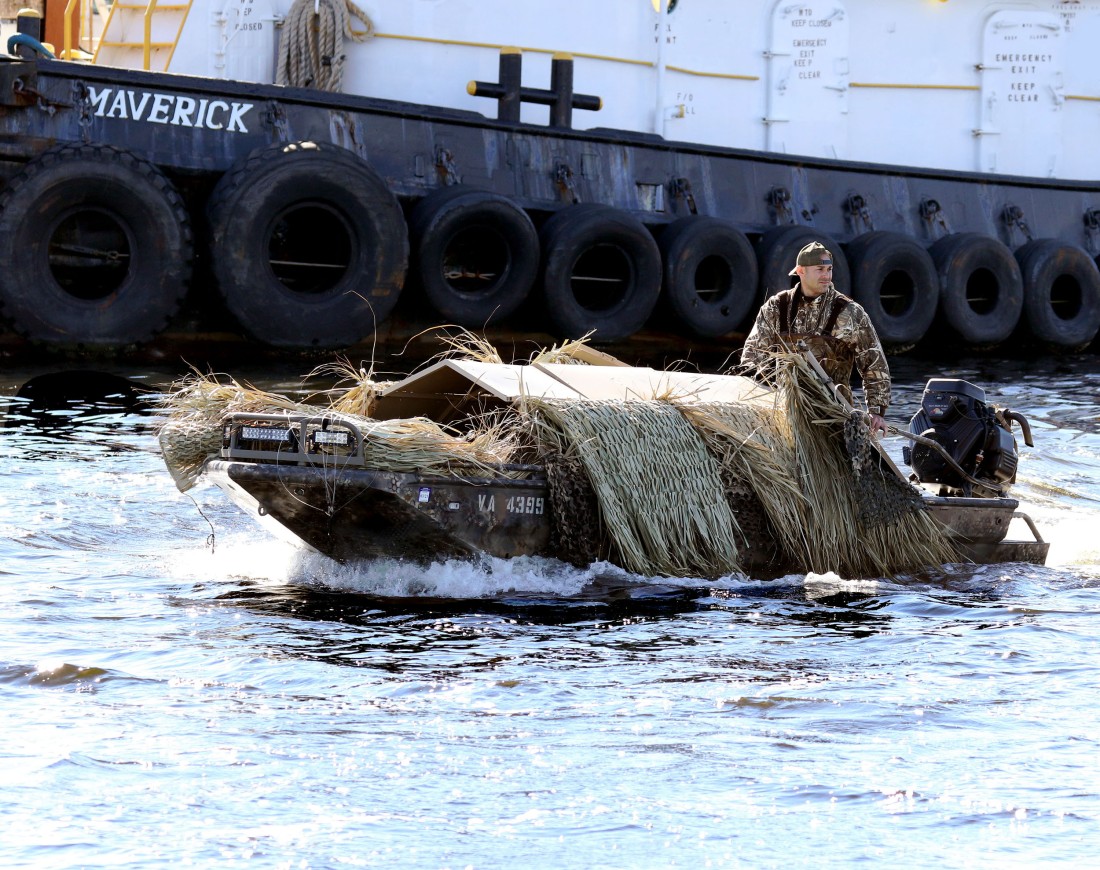
On 11/21/18, waterfowl season opening day, Rick was returning to port at Elizabeth River Park. His boat, fitted with an “Avery RealGrass” boat blind (made from dried palm leaves), really caught my eye. Per VA state regulations and based on breeding population trends, there’s a 2-goose daily limit during the 2018-2019 hunting seasons. And Rick had just killed his 2 Canada Geese. When I met him upon his arrival, I couldn’t help but ask him what he was going to do with them. He said with a grin, “I’m gonna smoke ’em and eat ’em.”
Canada Goose Training
A while later, I read up on those VA regulations. I learned, first of all, that the 2 geese Rick had taken in hunting were considered migratory game birds. Who knew? I also learned that those geese were members of the Atlantic Population that breed in northern Quebec and that winter from New England to North Carolina. I had no idea about that either. So then there’s a large and growing resident Canada Goose population in Virginia (and elsewhere). But there are good numbers of wintering and transient geese, as well. And those birds spend half of the year in the north.
I then continued my education in things Canada Goose as I read Maryland and Massachusetts bird listserv emails concerning recent goose sightings. Beginning on 3/13, there were MDBirds reports of large flocks of Canada Geese leaving Maryland and heading north. One person saw over 1000 birds fly over RFK Stadium in the space of 10 minutes. Another saw thousands of birds in several high-flying flocks over Woodbine. Then, days later, there were several reports on Massbird of a massive Canada Goose “influx.” One observer in Massachusetts reported seeing a “huge” flock that had settled in a cornfield in Sunderland.
And This Just In
I featured a photo of a leucistic White-throated Sparrow in my recent blog post, “Be Still and Know” (see “And This Just In”). Here’s another look at the same bird.
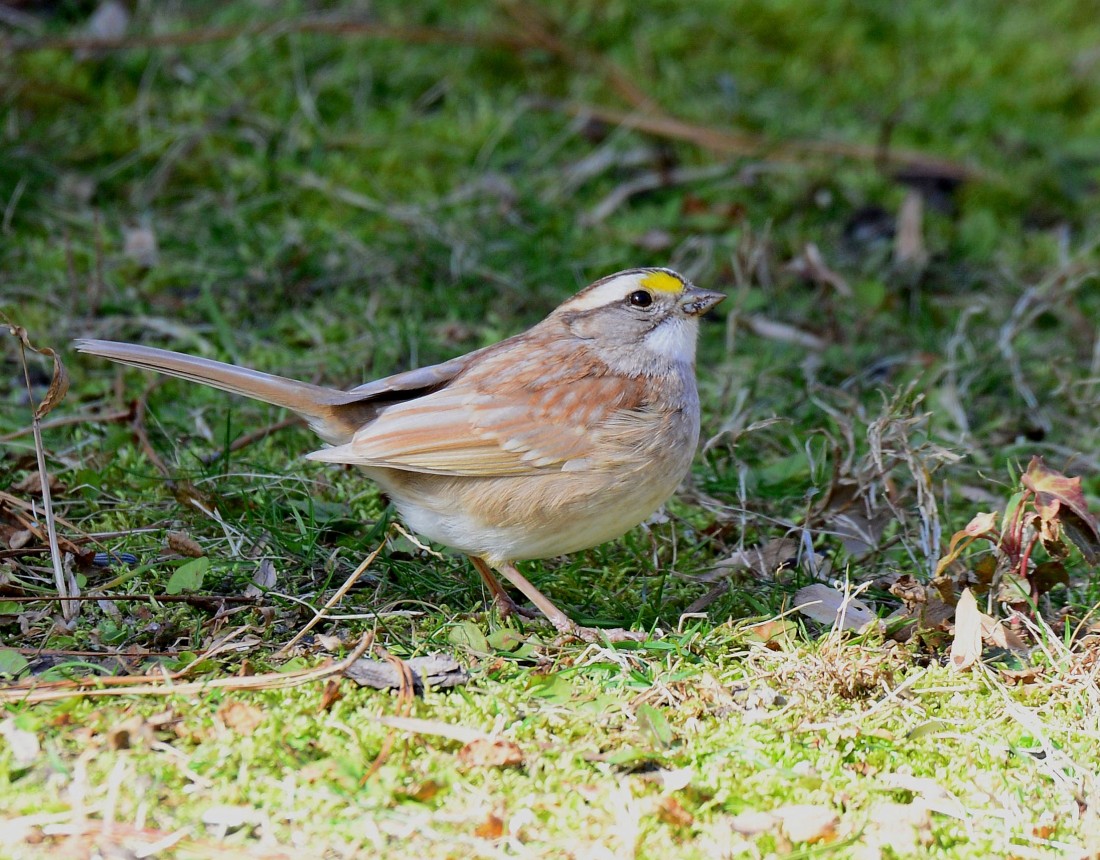
Leucism is a genetic condition that results in a loss of color-providing pigment, including the brownish-black pigment, melanin, in a bird’s feathers. Some leucistic birds have “diluted plumage” like the one above. Most, though, have patches of white like this American Robin, photo courtesy Michael Whited.
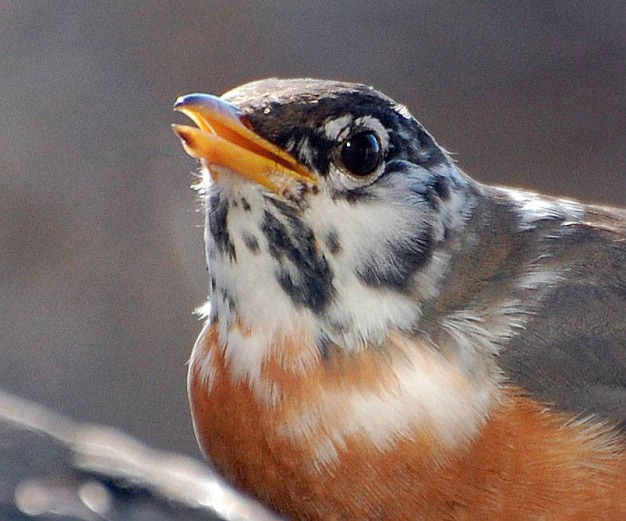
But some leucistic birds are completely white like this House Finch, photo courtesy of Pam Monahan.
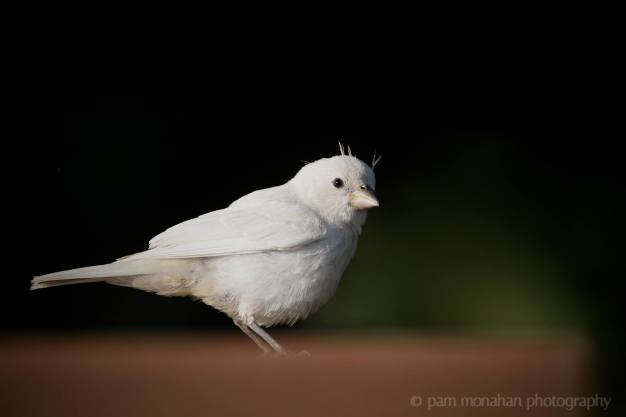
You’ll notice the normal iris pigmentation in Pam’s bird above. This indicates that the bird is a leucistic bird and not an albino. An albino, incapable of producing melanin altogether, would have no pigmentation there, resulting in a pink iris.
Quip, Question, Quote
Russ Ruffing of MD, in response to my “Why do you Bird” survey:
I bird for so many reasons! Probably the main reason is that I am absolutely intrigued with the movement of birds around our planet. Migration is the most fascinating phenomenon I can think of and birds are the most visible examples of that phenomenon. Yes I love the listing aspect of birding but I really try to see birds as individuals not as just a tick. When I see a migrating warbler, thrush, or what have you, I try to imagine where it came from and where might it be going. Have I seen this particular individual before? Have I been to its particular home territory in the tropics? Perhaps it passed through my yard the same week as it did last year? These thoughts really keep it interesting to me.
Second, the way that birds are tied to the ebb and flow of the seasons has literally grounded me to this planet for as long as I can remember. If I don’t go birding for a week in my home territory, I start to feel disconnected to my surroundings, like I need to answer the question of “what’s going on?” for myself. If I am traveling, I truly cannot really “know” where I am on the planet and feel comfortable there without plugging into the bird life of that area. Birds play such a huge part in defining a place, providing the musical soundtrack and the aesthetic backdrop of an area more than any other group in the animal kingdom. It is shocking to me that people in general pay literally no mind to this.
One Final Note
This is me with my “professional” recording equipment. Photo courtesy of my wife, Katie. I mentioned towards the end of my blog post, “Patchwork Quilt” that I often use a Tascam DR-05 with a Polsen SCL-1075 mic with a windscreen attached to record birds. But when I need a cleaner signal or when the bird I’m recording is farther away, I use the same recorder above but with a Wildtronics Amplified Omni mic, an easy-to-carry Wildtronics Parabolic Reflector, and a set of headphones.
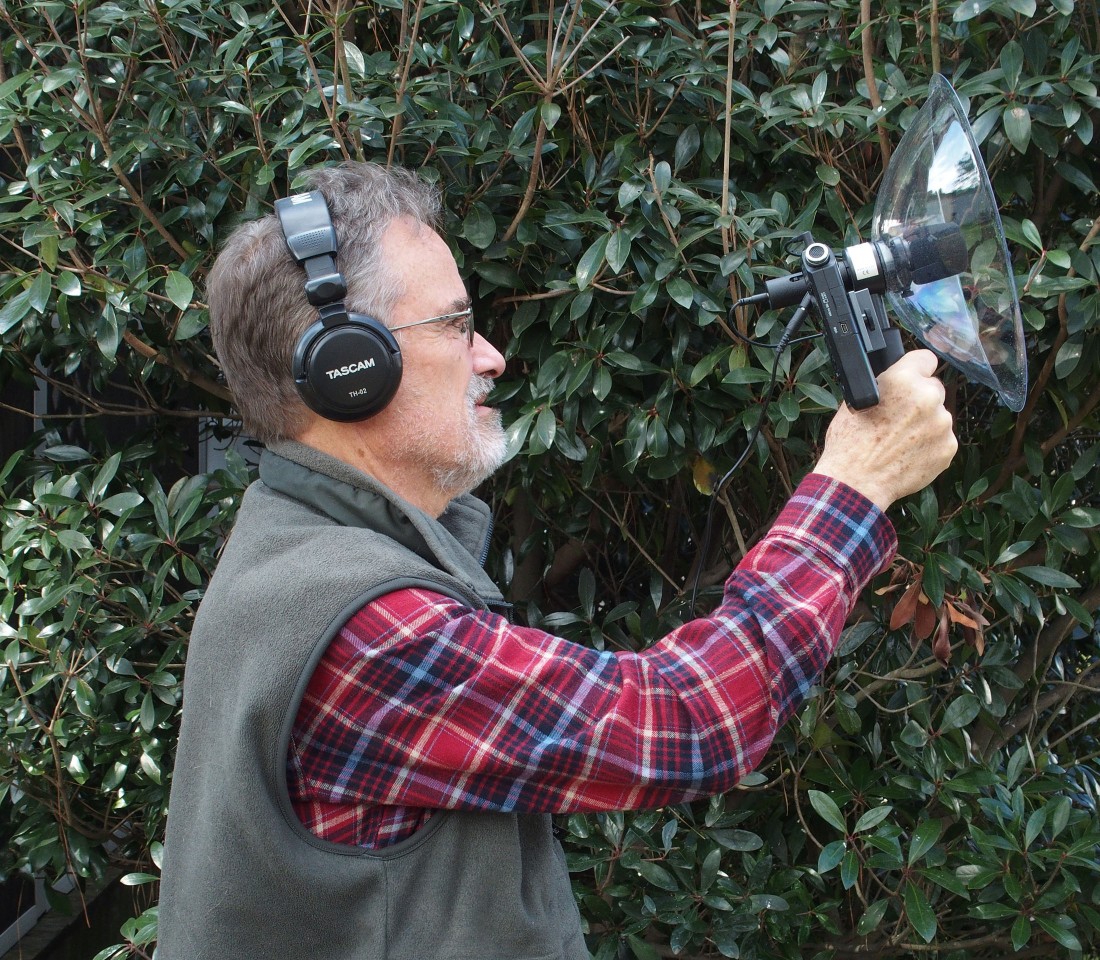
A few nights ago I used this setup to record a Northern Mockingbird. It was 2 am, and the bird was regaling the neighborhood from a perch in our ornamental pear. Here’s my recording:
I’ll have more to say about recording birds and about leucism and albinism in my next blog. I also hope to continue the discussion about the oft-maligned Canada Goose. So please stay tuned. And thank you, as always, for reading.
Awesome Dave. Keep it up. Super blog. I even took your recent advice and ordered a Tascam DR-05 and mic. Tried recording some american toads and spring peepers in the front pond with mixed results. I need some practice apparently and haven’t quite figured out how to configure the recorder and mic. Good birding, Doug Burkett
LikeLiked by 1 person
Doug, Thanks so much for your comment and kind words. Yes, learning about recording, setting up a recorder, and obtaining good recordings in the field all take time and patience. Here’s how I’ve set up my Tascam DR-05 (for use with the Polsen mic): WAV 24bit, 48K, mono, mic power: off, low cut: off, level control: auto level. I try to record only when there’s little wind and ambient noise. I also don’t record, if I can help it, in open spaces. I prefer sheltered ones, instead. The Polsen mic is directional, so it must be pointed right at the sound source, and that source can’t be too distant. (A pair of headphones could help here.) Having said that, I keep my mic on tele, not normal. You’ll also need to use more than the foam windscreen. You’ll need a “dead kitty” too. Here’s what I purchased from B&H, and it fits the mic perfectly: https://www.bhphotovideo.com/c/product/1047687-REG/auray_wsw_007mkii_fuzzy_windbuster_for_rovmr.html.
When you’re in the field (or backyard) try to position yourself so the mic is parallel to the wind direction. It might be best to have the wind at your back, but you could face the wind, as well. And if there’s any ambient noise (mowers, machinery, kids, etc.), try to position yourself so the noise is coming from either the left or the right of the mic. One last thing—you’ll need a pistol grip for the mic. You don’t want to directly handle the mic when recording. This one’ll work: https://www.bhphotovideo.com/c/product/885604-REG/auray_grip_universal_mic.html/pageID/accessory. Good luck, and let me know how you make out.
LikeLike
Oh my gosh Dave. Thanks for the detailed and extemely helpful recording primer. I’m heading out to Phoenix area and Joshua Tree this weekend for birds and desert super blooms. I’ll post pics on my Flickr site. Im just giddy. May get 20+ lifers. Sincerely, Doug Burkett
LikeLike
Doug, Have fun. I look forward to seeing the photos! FYI, I blogged about our recent trip to AZ. You might be interested in reading. I think I had 20 lifers there as well. Here are the links: https://birdpartner.com/2019/01/24/the-thrill-of-a-lifetime/ and https://birdpartner.com/2019/02/01/the-thrill-of-a-lifetime-part-two/.
LikeLike
Doug, I goofed in some of what I wrote about the wind and just made some edits. You actually want the wind blowing toward the mic or blowing from directly behind the mic. So it’s OK if you face the mic into the wind. Of course, it’s always better if there’s no wind at all!
LikeLike
The story of Canada Geese in Maryland is, for want of a better word, bizarre. Way back, migratory Canada Geese did NOT stop in Maryland. Most headed to the Carolinas. For more info on the history of the introduction of Canada Geese in Maryland, see this article: The Government Goose Plot That Flew Out of Control
https://cbf.typepad.com/bay_daily/2010/02/my-entry-2.html
LikeLike
James, Thanks so much, and fascinating stuff! I may include that link in my next post. All the best, Dave
LikeLike
James, I used all that good info in my latest blog. Thanks again for your help! Dave
LikeLike
Hi dave…great audio. How close were you to the geese. I noticed you have a parabolic mic…so many not that close?
LikeLike
Hi Jeremy, I recorded the geese with my shotgun mic. That’s an older recording, so I don’t recall how close I was. I can usually pick up sound fairly well with the shotgun up to about 30 feet (that’s a guess). With the parabolic mic, I can pick up sound farther away, but I have to make certain the mic is pointed right at the sound source. Hope this helps. And thanks for following the blog!
LikeLiked by 1 person
30 feet, that’s good reach for sure. I just got a rode stereo mic for nature ambiences but I’m thinking for individual birds a mono shotgun is sort of the way to do it..
LikeLike